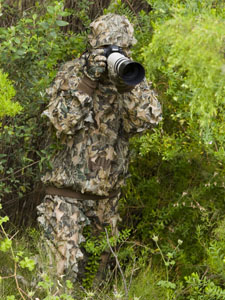Version
Version
Version
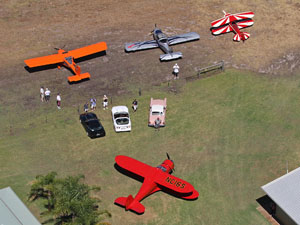
Over the last year or two I thought I was getting old as my body seemed to get tired more easily.
Over at least 12 months prior to going to hospital my unknown tumour was growing and damaging the pituitary gland (located at the base of the brain just behind the nose). I noted growing fatigue, a bit of dizziness, zeroing of my sex drive and a reduced ability to balance my temperature. On Saturday 13 Feb I was lucky to be invited to spend ~45 minutes in the back of a Cessna doing some aerial photography of 2 vintage planes in formation over Mundijong. The air was fairly bumpy and if the tumour had exploded that day it could have been tragic (the tumour at this stage was about 2.5 cm x 2 cm). Fortunately it felt like it may have stretched a little but my interesting life continued.
(Add ....)
After being sick for a couple of days I started getting double vision. Then my right eye lid started closing. I was admitted to the emergency department at St John of God hospital in Murdoch.
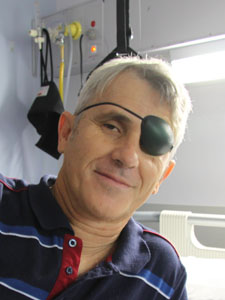
While waiting for an operation in hospital I used the pirate eye patch over my good left eye so that I could give my right eye some exercise without any eye strain.
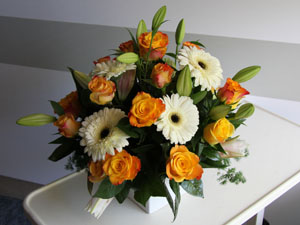
Many of my family, friends and colleagues cheered me up with best wishes, flowers, phone calls and visits.
Monday 15 Feb I had a normal day at work, went to bed at 9 pm in the evening and was sound asleep at 11 pm when the tumour 'burst' inside my head. I had an immediate splitting headache. At 11.01 pm I was vomiting in the kitchen sink. I had urgent needs to vomit intermittently until dawn. The horrible headache continued. I cancelled my work commitments. After a visit to my local GP on the Tuesday afternoon I got some medication for the vomiting and the headache. I had just had my first sick day since joining the Education Department in 1981!
Wednesday I stopped taking the medication but was still not fit for work with a nasty headache and growing double vision. Thursday the double vision intensified and my right eyelid closed. Friday morning I participated in a nearby school visit for a science laboratory upgrade but needed to lean on the wall occasionally (as noted by Paul, the Principal much later commented that I looked a bit yellow that day). By Saturday morning I had decided I was really sick and my symptoms were sufficiently distinctive to allow the local GP to refer me immediately to emergency at St John of God, Murdoch. By Saturday evening I had been given an emergency dose of hormones, a computed tomography (CT) scan and been admitted to hospital. Magnetic resonance imaging (MRI) later confirmed that the 'bursting' tumour took out most of my pituitary gland and that 'matter' had affected the nearby third nerve, causing the double vision and the closure of my right eye.
I had many meetings and tests as the most suitable operation details were worked out. The neurosurgeon explained all the options. The endocrinologist started me on replacement hormones to get me back towards normal. After stabilising on the cortisone and thyroxine hormones I was also given a new type of testosterone treatment. Fairly interesting as the gel is so strong that after it dries on my skin I have to cover it with a shirt. Neither women nor children are allowed to contact the treated skin (not even the wife) as the testosterone is strong enough to induce male changes. After 4 days of taking the gel I was reassured when some of my vanished sexuality returned!
Surgery to remove the tumour and clear the third nerve should help a lot. After a successful operation my future will require daily tablets to replace critical functions of the pituitary e.g. the production of cortisol and anti diuretic and and thyroid stimulating hormones. I will also need to take testosterone replacement hormones that were previously produced elsewhere but had been managed by the pituitary gland.
[While laying around in hospital I researched about getting solar photovoltaic panels installed on our house roof. I also considered the current and near future current viability of including more extensive solar and wind power on government buildings e.g. schools. I was able to jot down many thoughts and strategies for organising and simplifying my life - previously I did not have much spare time while I was busy at work on the Building Education Revolution and my health was less than 100%]
15 Feb 2010 pituitary apoplexy
18 Feb 2010 right III nerve paresis
20 Feb 2010 emergency admission at St John of God Hospital, Murdoch
21 Feb 2010 blood test:
Testosterone 0.1 nmol/L (normal range 8.0-27.8)
Thyroxine daily
(oral 1 hour before food)
Cortisone Acetate daily
Ranitidine daily
(both oral with food)
(Add CAT scan ....)
(Add MRI scans ....)
25 Feb 2010
Testogel 50 mg daily
(applied to chest)
Operation (1 Mar 2010)
As explained to me by the surgeons, my medical condition and the MRI showed that the best course of action was for microsurgery inside my head to remove the tumour. An ear, nose and throat surgeon (ENT) would clear the way for all necessary equipment to be at the top of my nose near the skull. The neurosurgeon would then take over and operate equipment inside the head to remove the tumour, clean up the pituitary site and back fill with fat from my stomach (to avoid any sagging of brain or optic nerves into the cleaned out areas).
MRI images had shown material on my third nerve which was causing double vision and the closing of the right eyelid. Great care was required by the neurosurgeon to avoid an artery that was very close to this area.
The operation started at 8 am. I remember talking to the anaesthetist ...
Trans-sphenoidal hypophysectomy of pituitary adenoma
(Add ....)
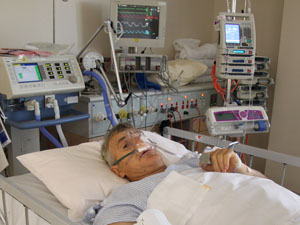
I woke up in the Intensive Care with my eyesight much improved!
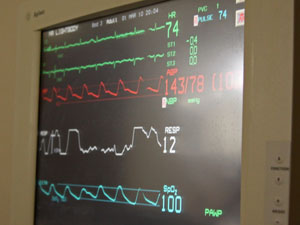
Some of my vital medical signs - heart rate, blood pressure and respiration.
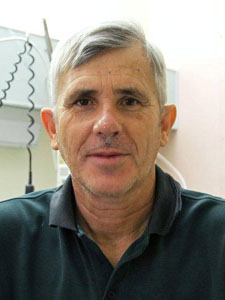
Safely back in my hospital ward after the operation - I was pleased that I did not have any black eyes or a bruised nose.
Post Operation (1 Mar 2010 to 4 March 2010)
I woke up in the Intensive Care Unit (ICU) around 4 pm. I effectively had my own personal nurse who fed me crushed ice to help with dryness in my mouth, I was receiving oxygen. I felt very good and relaxed. My wife visited me and took some photos of me in bed at my request.
A visit from the neurosurgeon was very reassuring as he verified that my double vision and droopy right eyelid were already much improved!
I obviously made good progress in ICU as I was shifted from a favoured high care position with my own nurse. Unfortunately I ended up in an awkward spot for me along a busy corridor (with frequent talking traffic), opposite a store and near an X-ray light box. Worse still I had been set up with a pneumatic cycling bed that went rigid with a firm lump in the middle of my back (about the same area as where I had my lumbar drain tube).
But my 'nightmare' was an electrical fault in a nearby electrical cupboard that caused a loud “BBMMP” clank every 2.5 seconds for the entire night. After sulking for an hour trying to get to sleep in an impossible situation – I “grew up”, started acting like an adult and watched television till midnight. It turned out that this electrical fault was unique to this location and caused by my hot air fan that provided warmth to keep my chest from getting chilled in the lower temperatures typically favoured in ICU and MRI areas of hospitals (but which in my case usually triggers my asthma).
I am eternally sorry to my night nurse Kay for my unhappy demeanour as I could not get to sleep and was still wide awake at dawn but extremely tired. I rallied again when the morning crew (Trisha & Angela ) removed the two blood soaked plugs from my nose. I negotiated no pain relief with them and there was not much discomfort.
Later, back in my ward again, crystal sachets requested by the ENT surgeon arrived, which meant I could begin nasal irrigation every 1 – 2 hours. This requires a strong determination as you squirt the solution up one side of your nose until blood runs out the other side of your nose and down your throat!! Repeat three times for each side of the nose.
I was described as a motivated patient (thank you Pip). I saved the nurses any hassle and gained immense improvement in the condition of my nose. I still occasionally seep a bit of blood from the nose (but this is just cosmetic).
Recovery of III nerve
Post operative MRI showed significant resection of the pituitary tumour
(Add MRI scans ....)
Thyroxine 100 mg daily
(oral 1 hour before food)
Cortisone Acetate 50 mg daily
Ranitidine 300 mg daily
(oral with food)
Testogel 50 mg daily
(applied to chest)
I asked my wife to drive me home much slower than any speed limits - I had not realized while in hospital how sensitive my head was to movement.
After the operation inside my head I was also bothered by bright lights, computer screens, mobile phones and strong sunshine.
I now need to take 3 types of tablets and apply Test-O-Gel every day for the rest of my life.
Recovering at Home (4 Mar 2010 to 31 Mar 2010)
The drive home from hospital was a reality check! My head was ultra sensitive and could feel every bump. I had to lay down horizontal immediately on reaching home. Later in the day I noticed that my hyper sensitive head could only handle a few minutes looking at a computer screen. It was also bothered by any nearby mobile phones - I could sense my mobile even when there were no calls or messages but it was doing a check signal with nearby phone towers! I could not handle listening to the radio or any music.
Even car travel 500 metres to the local GP was very uncomfortable - my renovated head definitely did not like car travel and needed quite a lot of horizontal rest time. I could not sit in the waiting room - had to lie down. Consequently I was signed off work till the end of March.
However my head feels better if I write down on paper my thoughts and feelings - even if it is 2 am in the morning. My body clock adapted to the hourly hospital checks in ICU and will not sleep for more than 2 hours before I wake up bursting with ideas.
I experimented by writing in the dark on my computer with both of the monitors at the lowest possible brightness settings - after a week I could manage sessions of 10 minutes before needing to lay down horizontal for an hour. As my head feels better if I write down things I asked a typist friend to help transcribe my many jottings while in hospital.
My health is improving. I still need to do nasal irrigation a few times a day. Currently taking Eutroxsig thyroxine tablets (before food, best kept refrigerated), Cortate cortisone and Ranitidine tablets (with food) and apply Test-O-Gel testosterone to my chest, later switched to abdomen after reading the directions I found in the bottom of the box.
In fact I feel like a new man - more oxygen up my renovated nose, head works better and seems comfortable on less than 6 hours sleep a day. I have started putting back on some weight (was down to 75 Kg in hospital) and had some yummy chocolate easter egg on the weekend. I have been very lucky. I had great medical staff and hospital facilities close to my home. I had a headache for a week, some minor discomfort and now need to take tablets each day for the rest of my life. My brain and body are working better! My new post 55, post pituitary lifestyle is looking pretty damn good!
[Our new SolarShop Australia photo voltaic (PV)solar power system will be installed on our home roof in a few weeks. This is just one initiative that has happened since my life changed - I will put additional ideas online as I finish working on them]
Thyroxine 100 mg daily
(oral 1 hour before food)
Cortisone Acetate 37 mg daily
Ranitidine 300 mg daily
(oral with food)
Testogel 50 mg daily
(applied to abdomen)
(Add ....)
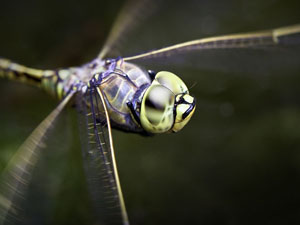
A dragonfly in flight at the bottom of Joffre Gorge.
Long Term (31 Mar 2010 onwards)
1 April - back working full time after a week of part days, also working out at the gym each morning before work. My head is now able to cope with computer work and my eyes are fine for photography.
21 April - after all clear from endocrinologist I attended a photography course in the gorges at Karijjni National Park (including climbing up and down cliffs with camera and tripod)
Only hiccup was getting the testosterone right - I thought hospital originally advised on chest but later when I read instructions it had a graphic showing stomach but not chest so I switched. However my stomach was too thick skinned for complete absorption so endocrinologist suggested switch to underarms and shoulders which is now working!
After 3-6 months I will need further medical tests and an MRI so that neurosurgeon can check on my health and verify the status of the tumour. I will also need to work with my endocrinologist to ensure that I remain healthy and am taking suitable amounts of each medication over time.
Blood test 15 Apr 2010:
Testosterone 5.6 nmol/L (normal range 8.0-27.8)
Thyroxine 100 mg daily
(oral 1 hour before food)
Cortisone Acetate 37 mg daily
(oral with food)
Testogel 50 mg daily
(applied to under arms and shoulders)
Blood test 14 May 2010:
Testosterone 13.3 nmol/L (normal range 8.0-27.8)
(Add ....)
